Earlier this year I reviewed the Primary Arms GLx 2.5-10X44mm riflescope and announced it as the sub $1,000 optic to beat. That is still very much my rarely humble opinion. That scope is likely as much as many hunters and shooters would ever need, as would serve them very well.
But there’s a lot of people who want to push it out a little farther, who need a larger objective and substantially more magnification for precise shots. A whole lot of those same folks don’t have the money for a new Leupold Mk V HD 5-25mm scope. For them, the Primary Arms GLx 6-24×50 FFP riflescope with their Athena BPR-MIL reticle is just the thing. This scope is every bit as good as the lower power version I reviewed earlier this year, but more suited to the precision rifle shooter needing to reach out a bit further.
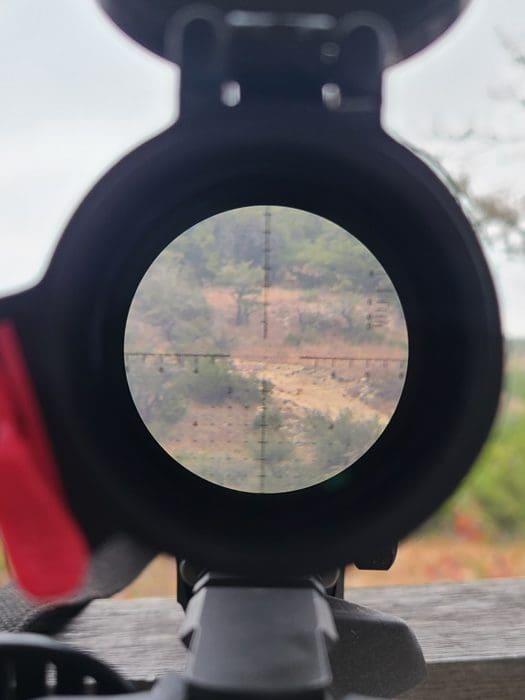
This is the same good glass I’ve seen in the previously reviewed scope. Take a look at the above photo. This is about as bad of a set up and conditions as you can get. Just after sunrise on a rainy morning, at 20X. The rock pile you see is about 800 yards away. The photo was taken with my camera phone held up freehand behind the glass, so there’s some focus and light lost there. You can see the clarity of the glass and the great light transmission. For this price, this Philippines made scope has some of the best glass on the market.
This scope comes with the same Athena BPR-MIL reticle I liked on their PLx series scope. I’m still shooting that one on a SCAR 20S and loving it. This is the first complex reticle I’ve found worth spending the time it takes to master.
There’s a whole lot of information provided for shooters who are willing to dedicate the time to memorizing the reticle. The center section is an open chevron. This allows the tip of the chevron to be used as a 6 o’clock hold on the target, so you get a very fine point and never obscure the target itself. To the left and right are dots and hashes, and below is the now familiar Christmas tree for holding both windage and elevation at the same time. Once memorized, this reticle allows the shooter to very quickly engage multiple targets, as well as cuts down dialing time to, well zero.
The upper left of the reticle includes a ranging ladder, common in many military themed scopes. Deployed in Afghanistan, I found these ranging ladders (mine was on the ACOG) extremely useful, but not for my own shooting. They provided close enough measurement to relay back to the belt fed guns and the Mk19 to engage quickly.
For precision shooting, they rely on knowing your target size. For target shooting, this works well, as you often know the target size. For hunting, it’s only so helpful, as game size ranges so much. For instance, White Tail deer can range from 14″ to 20″ from belly to back, depending on age, sex, and region. I have two taxidermied coyotes taken off the same land. One is 17″ from shoulder to rump, the other is 20″.
This is a First Focal Plane scope, so the reticle will size with the magnification, which allows for the same ranging techniques at any magnification. This does mean that you may have to dial back the magnifications if you need a lot of windage on small targets far away in order to see the substentions. As always, there’s a compromise for everything.
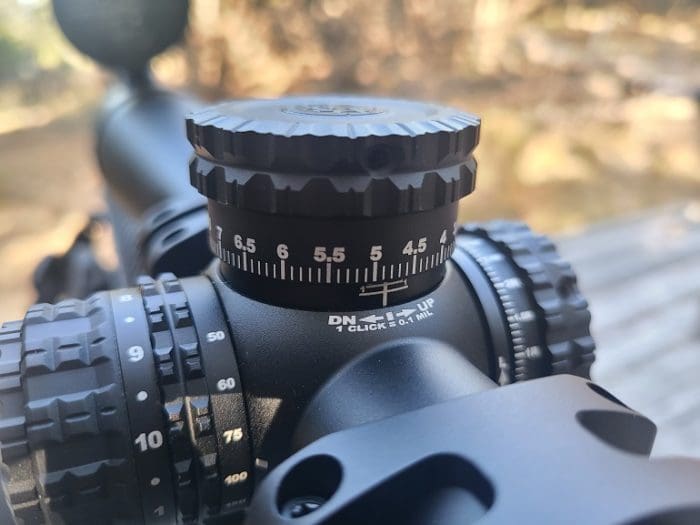
As I have done with previous Primary Arms Scopes, I checked to make sure the turrets were accurate and returned to zero. I did this through a simple box test, but also just turning both turrets all the way, each way, 10 times for each turret. I returned it to zero and then shot a round at a target 100 yards away. My round landed within an inch of the round I shot prior to moving the turrets in the first place.
Keeping the set-up simple, I left the target at 100 yards, and marked two horizontal lines 18″ apart. I aimed at the bottom one, dialed 5 mils up, and shot a round. It landed within an inch of the top line. I did this a few times each way, and then did the same with the windage. The turrets track.
They also move quite a bit. There’s 17.7 mils of elevation adjustment and 11.8 mils of windage. Assuming you are shooting standard M118LR ammo from a 20″ rifle and zeroed at 100 yards, you’ll be past 1,200 yards before you run out of elevation. And that’s in the unfortunate and unlikely case that you have a flat mount with zero angle and you aren’t using the additional 16 mils of elevation available in the reticle. Obviously, flatter shooting rounds than the old, fat, and slow .308 Winchester will have even less of an issue.
Just like the smaller GLx scopes, the 6-24X50 is packed with solid features.
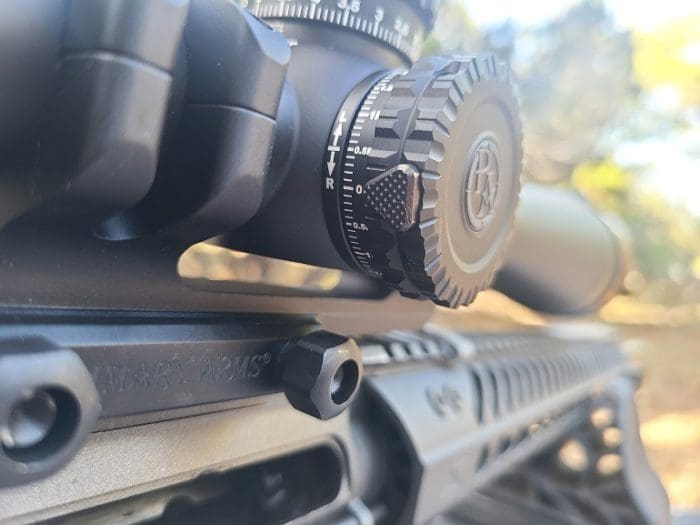
The windage and elevation turrets each have a button release/lock. The turrets move well, and I would find it unlikely that they would move inadvertently, and even if so they return to zero with a zero stop. In short, the turrets release/lock buttons are nice, but unnecessary. Since they don’t require a hard push or hold that would move the glass off target during manipulation (like most pull-up models) I’m good with them.
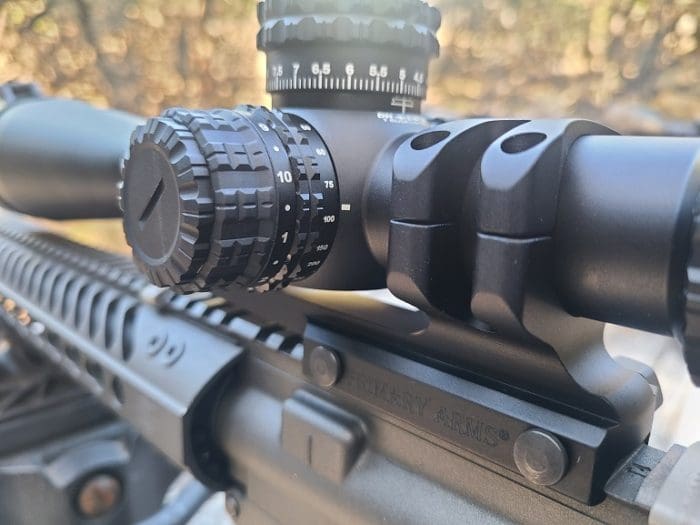
Also, just like the previous GLx scope, the parallax knob is well done, but difficult to turn out-of-the-box. Just turn it a bunch right upon opening and the issue resolves.
You’ll also find the same great illumination controls on the left side, with the same common battery, and the “off” between each setting. The illumination does dial down enough, and the illuminated reticle is sharp enough, that it functions acceptably well at the lower magnification powers with an AN PVS 14 night vision monocular.
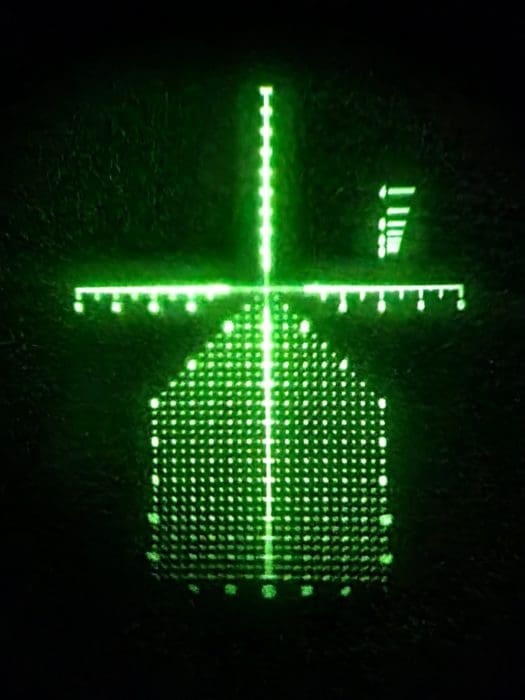
Positioning the monocular and mounting it in the right spot behind the glass can be a tedious procedure. The photo above is the illumination on the lowest night vision setting as seen through my monocular, inside a closet.
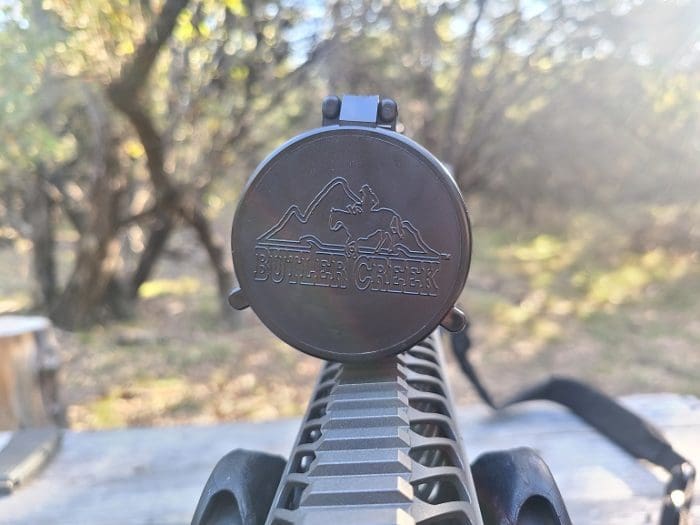
And just like before, the scope comes with Butler Creek lens caps right from the manufacturer. Other than a scope level and rings, the scope is great as soon as you buy it.
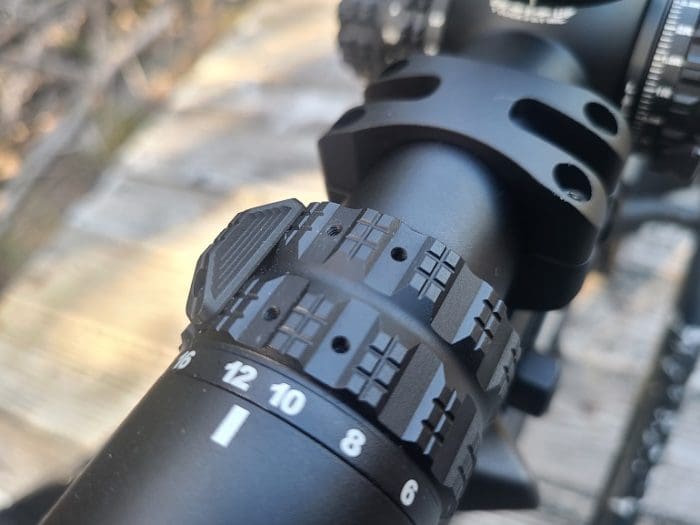
The magnification adjustment ring on the GLx line is unlike any other, and smarter. It moves well and stays in place, but it also has an adjustable raised portion for easier movement when you are behind the glass. This section can be moved on the ring to better suite the needs of the shooter.
One thing that surprised me was the eye relief. This is another place where budget scopes tend to go awry, but the GLx has 3.5″ at its highest magnification. Not bad at all. That makes getting behind the scope and ready to shoot fast and repeatable.
With a 50mm objective, the scope allows for a great field of view and good light. The downside is that it is not small or lightweight. At 24.5oz, it’s neither the heaviest, or the lightest in the class.
The Primary Arms GLx 6-2450mm is every bit as good as the previous GLx line I reviewed so highly. This one’s just bigger, and includes the Athena BPR-MIL reticle I liked so much on their PLx line.
Specifications: Primary Arms GLx 6-2450mm with Athena BRP-MIL
Click Value: 0.1 Mil
Exit Pupil Diameter: Low: 8.10 mm / High: 2.20 mm
Eye Relief: Low: 3.60 in / High: 3.50 in
Field View 100; Low: 15.20 ft / High: 4.20 ft
Focal Plane: First Focal Plane
Illuminated: Full Illumination
Maximum Magnification: 24
Minimum Magnification: 6
Night Vision Compatible: Yes
Objective Diameter: 50mm
Reticle: Athena BPR MIL
Reticle Type: MRAD
Total Elevation Adjustment: 17.5 MIL
Total Windage Adjustment: 11.6 MIL
Tube Diameter: 30mm
Weight: 24.5 Oz.
MSRP: $799 (actual purchase price on Primary Arms website)
Rating (out of five stars):
Overall * * * * *
Best in class by a bit. This is the second of the GLx line I’ve reviewed, and the one with the largest objective and highest magnification. It’s very surprising this level of quality is out at such a low price.





Alternative review for you TLDRers:
Just like the other one but bigger.
if you want to send it to me in the mail, I’ll take some nice pictures through it with a good camera!
You called me a “fool and an asshole” and now you come with your hand out.
I have to live with, work with, and deal with all sorts of jerks, assholes, schmucks, morons, idiots, fools, losers, ad nauseum, that I come into contact with repeatedly. I have learned that it is better to take it one day at a time and see if I can make the next day better by forgetting yesterday. sometimes I am left disappointed, sometimes a jerk doesn’t feel like being a jerk anymore. either way it makes me a better person for trying to make the world a better place.
I’m no different than anybody else. we all have that same situation. so do you.
Gus, you haven’t figured out the common denominator with all those “jerks, assholes, schmucks, morons, idiots, fools, losers” is you.
The dissapointing jerk in your story is in your mirror.
I’m with you, JWT. You and I don’t agree on everything, but I certainly respect you. If gus hasn’t figured that out, it’s on him and not you. I enjoy your gear reviews, and know they take a lot of work. I don’t have the time to do gear reviews, but certainly wish I did. I appreciate those who do, as gear reviews are usually the best part of TTAG.
Also, I don’t believe that Epstein killed himself or that Biden got 80 million votes.
Accurate, thanks and I hope you are not feeling too demoralized out there. For years you’ve been walking the talk around here and please know that, sure, we don’t always agree, but I respect the heck out of you.
Wow. Great price point for its features.
In other articles and comments on rifle scopes, I have questioned whether the super-duper (and insanely expensive) scopes really do produce far superior image quality compared to scopes in the $300 to $700 price range.
I imagine the super-duper and super-expensive rifle scope images are better. Given that the super-super scopes cost anywhere from 3 to 8 times more than less expensive rifle scopes, are their images 3 to 8 times “better” (whatever that means subjectively)? I highly doubt it.
Caveat: I don’t doubt that, 30 years ago, super-duper rifle scopes produced far better images than less expensive scopes. What I am proposing is that there is far, far less difference in image quality in scopes manufactured in the last two or three years. In support of my position, as I mentioned in one of my previous comments, the image brightness, sharpness, and contrast of a $300 Nikon rifle scope that I previously purchased was astounding. Looking into extremely deep/dark shadow with the sun low and just barely off-axis did not seem to degrade my ability to see clearly into that extremely deep/dark shadow. And looking into deep shadow at 30 minutes after sunset I was able to see all the detail that I needed to see. I am simply having a hard time imagining how a $2000 rifle scope could provide significantly better images. Marginally better? Sure. Significantly better? I doubt it.
Look through a Schmidt and Bender, US Optics, or a Loopy Mk 5 or 6 and see if you have that same opinion. The optics and clarity are phenomenal. My Burris XTR, Bushnell ERS, Vortex PSTs and Strike Eagles just don’t compare. If there was no difference between $1000, $3000, and $5000 glass, no one would buy them.
Take a look at my last review on the Leupold Santiam spotting scope for an explanation of the differences.
I really dig the ACSS-Aurora BDC reticle on the PA SLX 1-6×24 and was thinking how nice that would be on a scope like this. but after looking at the christmas tree, it becomes apparent how much this is suited for looong range more or less stationary targets, while the ACSS is more suitable for closer moving targets. yep BDC is out for long range and mil-dots are in.
plus a pro shooter isn’t limited to what ammo/barrel/etc that a BDC will accept. calculate the mil dots and he can use the scope with anything.
How does my Horus 5-20×50 compare to your Aurora BDC? I put mine on a Savage 12 LRP 6.5 creedmore.
who me? you didn’t say which model but I looked on their website and they have several reticles that look like the christmas tree in the OP, with evenly spaced dots, but they are marked 2 thru 10 etc. where a BDC would have sort of a logarithmic spacing. so I don’t think those have a BDC function, just straight mil-dot.
https://www.horusvision.com/horus-reticles
I would guess you have a Horus Tremor reticle. how do they compare to an ACSS-Aurora BDC reticle? to start with, the Tremor is a mil-dot where you figure it out yourself, and an ACSS reticle has bars and lines that TELL you where to hold. there may be dots on the side for wind drift but those do not serve the same function as mil-dots.
like said above, a BDC is better for close to intermediate range (out to 600-800 yards) and the goodies on the side for moving targets work out to 300 yards at most, and the whole thing is specifically calibrated to your barrel length and ammo. a mil-dot reticle can be used with anything, and the big christmas tree types like Tremor or Athena BRP are slower and more difficult to use but much better suited for long range stationary targets and dealing with wind drift, for any combination of barrel and ammo you can throw at it.
the ACSS only one type of BDC. there are 25 flavors of ACSS which have an ACSS vertical bar at the core and extra doodads tacked on the side. see here for a listing, these are the guys that invented it. go to the “reticle name” sidebar.
https://www.primaryarms.com/2+With-ACSS/MCategories+Optics
if you mean which style might be better on your scope, it depends on what you want to do with it.
I’ll say one thing, their reticle demo is badass and sure was fun to play with!
https://www.horusvision.com/reticle-demo
Best site very good blog primary arms scopes
I get all information from this after so many searches.
I’d be curious to see your guys opinion on some other sub $1K scopes such as Brownells MPO 3-18X and 5-25X offerings….
OK… I typed that before I found your review of the 5-25….As you were lads…..
Nice Review! The Features are awesome pair it with the speedloader i buy at https://amzn.to/3l4yKQC
Comments are closed.